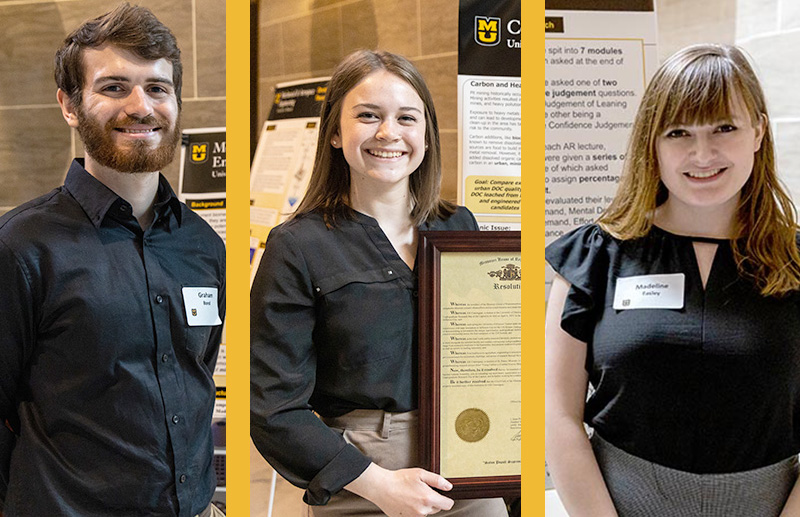April 10, 2023

Three Mizzou Engineers were among a delegate of 10 representing University of Missouri research at the Missouri State Capitol on Thursday.
Graham Bond, Elli Castonguay and Madeline Easley were selected to participate in Undergraduate Research Day at the Capitol, an annual event that showcases innovations taking place at Mizzou, as well as the other three UM System campuses. Students presented their research to legislators and state agencies.
“Making connections with other students, with lawmakers and with the larger community is the best possible way to push academic research into the forefront,” Bond said. “Opportunities like this are particularly useful because they force us to step out of the academic sector and explain research in a widely understandable way, which will be an important skill for the rest of our careers.”
“It’s a great opportunity to explain research to a non-science community,” Castonguay added. “That’s a good skill to have.”
About the projects

Bond’s project focuses on using cutting-edge 4D printing and tissue engineering techniques to kickstart the next generation of personalized and adaptive biomedical devices.
“While 3D printing creates rigid products, 4D printing is a new method to manufacture structures that can change shape over time, typically from the addition of heat,” said Bond, a junior in mechanical engineering from Jefferson City.
He and team members in Associate Professor Jian Lin’s lab are developing a novel polymer that can change shape when placed in the warmth of a human body. They mix the polymer with sugar before printing a 3D structure, then dissolve the sugar to leave behind a matrix of pores for tissues to grow upon.
“This construction method can be used to precisely control mechanical strength, porosity, transition temperature and shape, allowing for comprehensive and personalized biomedical devices,” he said.
He hopes lawmakers gained a better understanding of how using an interdisciplinary approach allows researchers to build technologies of the future.
“My research combines knowledge from mechanical, biomedical, and chemical engineering with materials science to provide a tangible step toward more personalized medicine,” Bond said. “The long-term goal of this research field is printing devices that closely resemble human tissues, and eventually 3D printing organs. Progress towards these goals is only possible through a holistic approach and through collaboration across fields.”

Castonguay shared findings from her ongoing work around the health of streams in Joplin, Missouri, which is still impacted by pit mining that took place in the area for over a century.
“The health of streams is important to the community,” said Castonguay, a civil and environmental engineering major from St. Peter’s, Missouri. “We’re wanting to find solutions for that environment and also one that other communities can apply, as well.”
Castonguay is working with postdoctoral fellow Sarah Fischer and collaborators to collect water to determine the presence and condition of carbon, which serves as a food source to microorganisms and impacts the health of a stream. Using optical spectroscopy, they’re analyzing the quality of carbon, comparing stream water against lab experiments where carbon is added.
“My results showed that the carbon in the treated and untreated water samples were significantly different in the amended run-off — the carbon was found to be larger and thus a longer-lasting food source for the bacteria removing heavy metals,” she said. “The overall goal of my work is to demonstrate how engineered carbon amendments could facilitate heavy metal removal. Ultimately, we want to develop a remedial solution for this stream using locally sourced materials.”
She hopes the work demonstrated to legislators that research topics are relevant to Missouri communities and that outcomes can improve the lives of Missourians.
Undergraduate Research Day is the second time she’s presented her work in recent weeks. Over spring break, Castonguay attended the American Chemical Society’s (ACS) Spring Meeting in Indianapolis, Indiana, having been awarded an ACS Women Chemists Committee Travel Award sponsored by Eli Lilly & Company.
“It was the first national conference I’ve attended, and it was cool to be around so many researchers and see the work that’s being done. It was eye-opening,” she said. “I was also fortunate to receive the Eli Lilly scholarship and network with other women working in chemistry and science.”
Castonguay is graduating in May but will remain at Mizzou. Seeing the impact of her research inspired her to continue on to pursue a master’s in civil and environmental engineering.

Easley presented her research on implementing augmented reality (AR) into education. It’s one of few metacognition studies focused on AR environments in a college setting.
With faculty mentor Jung Hyup Kim, an assistant professor in industrial and systems engineering, Easley is investigating the effect of self-evaluations, judgements and student confidence in an AR learning environment. These environments use AR headsets to add virtual elements to a student’s field of view without replacing all physical surroundings. The aim is to create useful visual aids that will help students better understand difficult concepts.
The team collected metacognitive monitoring questionnaires from two groups of students exposed to the same AR experience. One group reported retrospective confidence judgments, and the other reported their judgement of learning.
So far, findings indicate that students are able to learn in AR settings similarly to how they learn in traditional classrooms.
Easley, a senior from Troy, Missouri, is also graduating in May.
Join an engineering program that lets you solve real-world problems. Apply to Mizzou Engineering today!